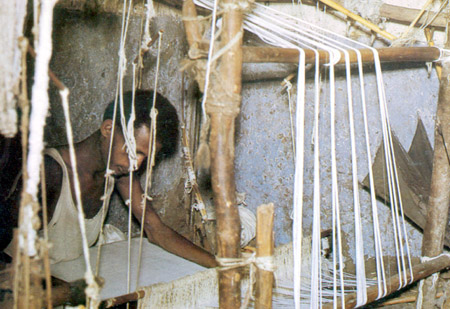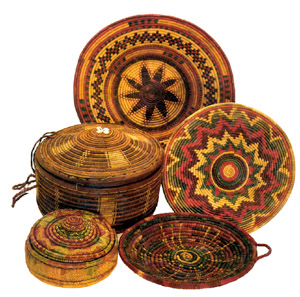
Folkloric Yemeni Handicrafts Originality That Remains [Archives:2001/44/Culture]
October 22 2001

Saleh Abdulbaqi
Cultural Editor
Yemen Times
Yemen’s traditional heritage is known for its different cultural varieties that harmonize with the varied climate, relief and local environment. The difference in life on mountains, valleys and deserts constitutes very interesting and colorful traditions.
Yemeni traditions also vary in accordance with the economic production be it agricultural, industrial, handicraft, commercial, political, etc. Such diversity is noticeable in men’s appearance, habits, conventions, etc., creating a unique Yemeni panorama with many colorful pictures that is less seen in other countries in the peninsula. The roughness of Yemen’s geography inspired Yemenis to adapt themselves to life here and to tackle all difficulties by reason. Dams, irrigation canals, fortresses, irrigation terraces and roads are examples of the ability of Yemenis to exploit nature for their benefit.
For a long time, the majority of Yemeni people depended on agriculture for their livelihood. In this regard, the Yemenis thought of a better means to improve their own standards and achieve self-sufficiency without resorting to foreign assistance. Undoubtedly, these handicrafts suggest the deep originality of the Yemenis and their creative capacity. The most well known handicrafts are silver products, jambiyyas, jewelry, clothing, pots, earthenware, and earthen jars.
The old city of Sana’a is also distinguished for its trade market, which is the most important means of living for the residents. It is known as al-Melh Market. It was the most important trade center for all the commercial caravans that used to come to Yemen from neighboring areas including al-Sham and al-Hijaz. Yemen at the time used to be a very rich agricultural country. Many agricultural products used to be exported from the country. Of the important agricultural products are coffee, Sana’ani almonds, fruits, etc. In the market there also used to be special places for those who came from other countries to stay in for some time to buy things. The market also contains clothes, silver, traditional jewelry shops, etc., for which Yemen has long been famous. The market retains many of its features and merits.
The craftsmen did their best to provide the essential materials to live in this universe. They used palm leaves to roof their houses.
Despite the huge development of clothes manufacturing at the present time, a great number of Yemenis do still cling fast to these clothes and to the art of embroidering them. Social markets are rich with these products that stand witness to a great history.
The textile handicraft is an ancient activity in our country. It has become the main means of livelihood of some families. One thing to notice is that the new embroidered products have been given a new form that restores the traditional features and is mixed with a sense of modernity.

Many visitors express their admiration and respect of such products when seeing them at markets. The excellency of women when embroidering the brides’ clothes is really praiseworthy; none could help but admire it. Most of the embroidery is taken from the beauty of nature. You can see, for example, some bees that have been magnificently woven to indicate the honeymoon. However, embroidering varies from one area to another.
Yemen is bestowed with a unique culture that could be a very good source of income if it is taken care of properly. Developing public awareness towards the preservation of cultural heritage is of great priority.
——
[archive-e:44-v:2001-y:2001-d:2001-10-22-p:./2001/iss44/culture.htm]


